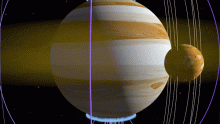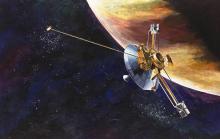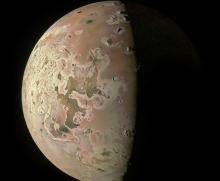Listen to today's episode of StarDate on the web the same day it airs in high-quality streaming audio without any extra ads or announcements. Choose a $8 one-month pass, or listen every day for a year for just $30.
You are here
Moon and Jupiter
Jupiter is the third-brightest object in the night sky — only the Moon and Venus outshine it. If our eyes were sensitive to infrared light, Jupiter would look even brighter. That’s because it radiates about twice as much energy into space as it receives from the Sun — all in the infrared.
Scientists still aren’t sure what powers Jupiter’s internal heat. But they have some ideas.
Some of the heat may be left over from Jupiter’s birth. Current models say that when Jupiter was young, its internal temperature was about twice what it is now. Over the eons, much of that heat flowed into space, making Jupiter cooler and smaller.
Some of the heat may come from that contraction. Gravity squeezes the planet, making it shrink. Today, Jupiter is shrinking by about one millimeter per year, making it hotter.
And yet another idea says that a “rain” of liquid helium plunges through Jupiter’s interior. At greater depths, it’s heated. The droplets vaporize, releasing their heat into the surroundings. Some of that heat then rises through Jupiter’s outer layers and flows into space — helping Jupiter glow brightly in the infrared.
Look for Jupiter near the gibbous Moon tonight. The solar system’s largest planet looks like a brilliant star. It’s to the lower left of the Moon at nightfall. The Moon will slide closer to Jupiter during the night. They’ll be at their closest as they set, a couple of hours before dawn.
Script by Damond Benningfield






